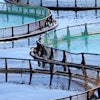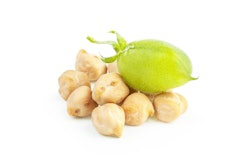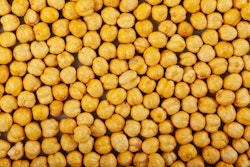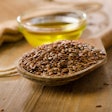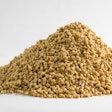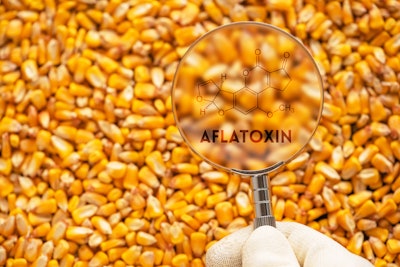
Aflatoxins are naturally occurring mycotoxins produced by certain molds, primarily Aspergillus flavus and Aspergillus parasiticus. These toxic compounds can contaminate animal feed, posing significant health risks to livestock and poultry. In this article, we will discuss which animal feed ingredients are more prone to aflatoxin contamination, when the risk of contamination is higher and strategies to mitigate its effects on animals.
Animal feed ingredients prone to aflatoxins
Certain animal feed ingredients are more susceptible to aflatoxin contamination and, although this is not a hard rule, it is worth keeping in mind. These ingredients include:
Corn: Corn can be easily contaminated by mycotoxins and especially aflatoxins. The risk is even higher in warm and humid climates. Aflatoxins proliferate on corn when it is exposed to moisture and stored improperly.
Peanuts: Peanuts are also highly susceptible to aflatoxin contamination, as they are often grown in conditions conducive to mold growth. Aflatoxins can accumulate on raw peanuts and peanut meal used in animal feed.
Cottonseed meal: Cottonseed meal can be contaminated with aflatoxins during the harvesting and storage processes. As a large part of cottonseeds are used in dairy nutrition, care should be taken avoid their transfer to milk.
Tree nuts: Almonds, walnuts and pistachios are at risk of aflatoxin contamination, particularly if they come into contact with moisture. These are not fed to animals, but byproducts are infrequently found in animal feeds, often at high quantities (locally).
Oilseeds: Various oilseeds, such as sunflower, rapeseed and soybeans, can become contaminated with aflatoxins under the right conditions.
When is the risk of contamination higher?
The risk of aflatoxin contamination in animal feed is higher under specific conditions as explained below, without being an all-inclusive list.
Environmental factors: Warm and humid climates promote the growth of aflatoxin-producing molds. Regions with these weather conditions are more prone to aflatoxin contamination in crops such as corn, peanuts and cottonseeds.
Storage conditions: Inadequate storage practices, including poor ventilation and high moisture levels, create a favorable environment for aflatoxin growth. Aflatoxins can proliferate during storage, especially in damp or poorly maintained silos and warehouses.
Crop management: Inadequate crop management practices, such as improper drying and handling (causing broken kernels, for example), can increase the risk of aflatoxin contamination.
Harvest timing: Harvesting crops too early or too late can contribute to aflatoxin contamination. For instance, delayed harvesting may expose crops to moisture, while harvesting too early may result in immature, more susceptible kernels with higher innate moisture.
Mitigating aflatoxin contamination effects in animals
To protect animals from the harmful effects of aflatoxin-contaminated feed, the following mitigation strategies can be implemented:
Regular testing: Implement a rigorous testing program to monitor the presence of aflatoxins in feed ingredients. This ensures early detection of contamination.
Proper storage: Maintain proper storage conditions by keeping feed ingredients dry, cool, and well-ventilated. Implementing a first-in, first-out storage system can help reduce the risk of aflatoxin exposure.
Use of mycotoxin binders: Some feed additives, known as mycotoxin binders, can adsorb aflatoxins, reducing their bioavailability and toxicity to animals.
Dilution: If feed ingredients are found to be contaminated, they can be diluted with uncontaminated materials to lower aflatoxin concentrations in the overall diet.
In conclusion, aflatoxin contamination in animal feed is a serious concern, with certain ingredients and environmental conditions posing a higher risk. To safeguard animal health, it is crucial to implement preventive measures such as proper storage and handling, testing and the use of mycotoxin binders, to ultimately minimize the harmful effects of aflatoxins.

